#papyrifera
Text

on the shore of lake michigan // march 25th, 2023
#puremichigan#michigan#lake michigan#up north#sleeping bear dunes#photographers of tumblr#original photography#birch#paper birch#white birch#betula papyrifera#march#winter#spring#snow#blue#white#sand dunes#glen arbor#fleetingfutures#mine
20 notes
·
View notes
Text
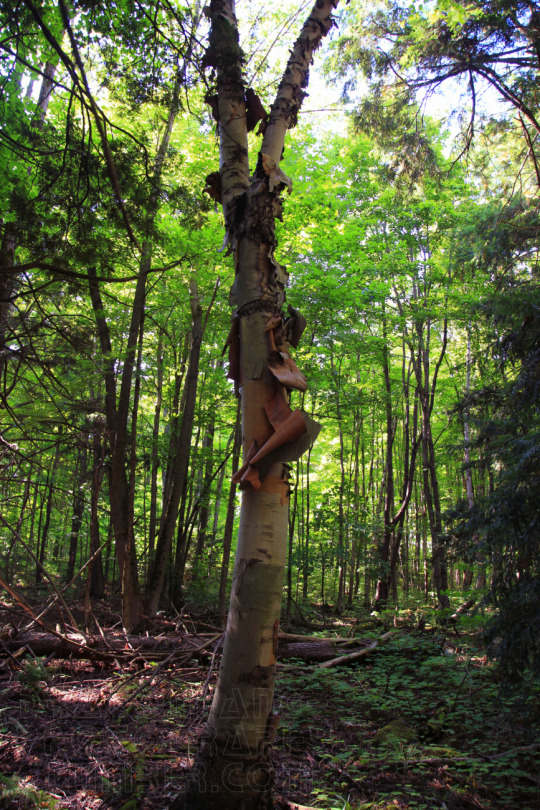
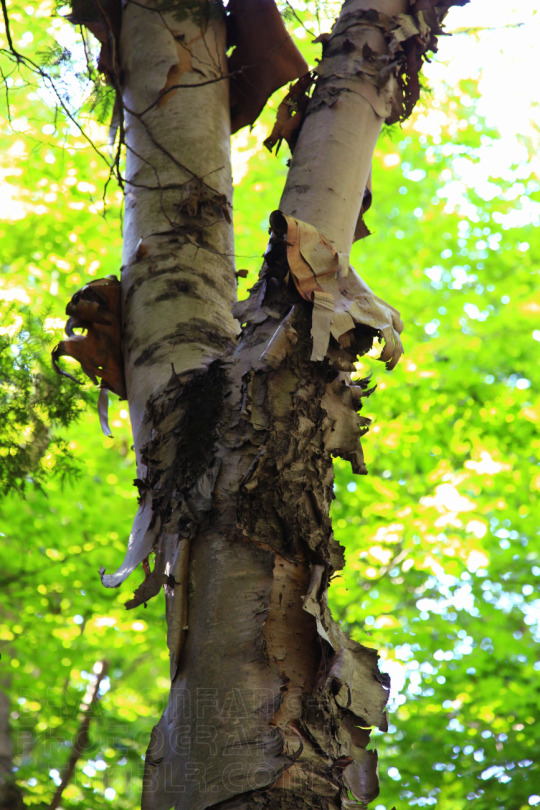
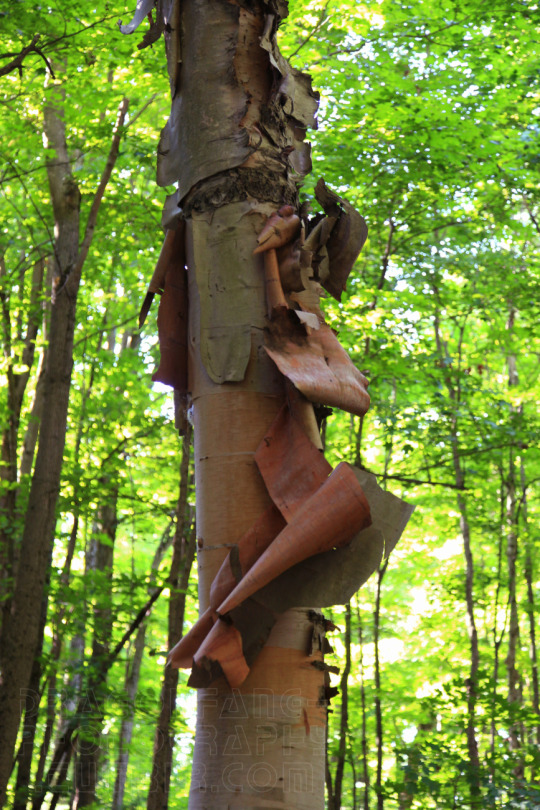
Betula papyrifera, the white birch.
#Bruce Trail#Sydenham section#Niagara Escarpment#Bruce County#Ontario#Canada#hiking#hiking trail#forest#trees#wilderness#outdoors#landscape#birch#birch tree#Betula papyrifera#white birch#paper birch#photography#digital photography#DSLR#Canon 6D#photographers on Tumblr
13 notes
·
View notes
Text
dendrology at 8:30 am who up
0 notes
Text
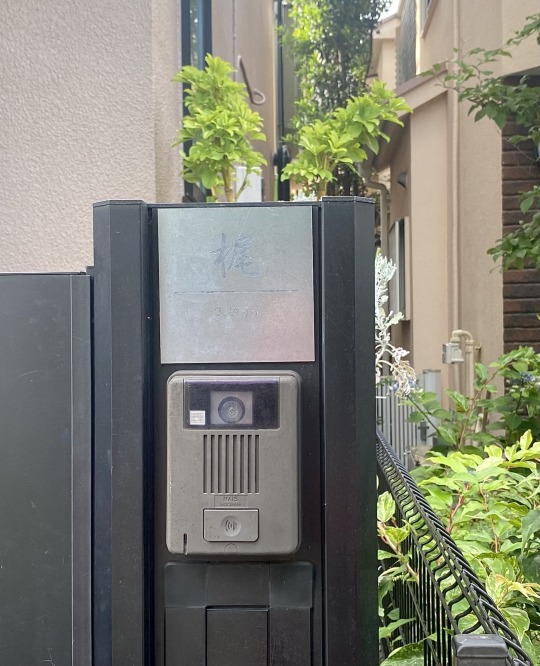
A ghost of a nameplate! I could barely make it out in the bright sun, but today’s name is 梶 Kaji.
Outside of names, 梶 means sculling oar, rudder/helm, or paper mulberry tree (Broussonetia papyrifera). The radicals are 木 tree and 尾 tail. It's read かじ, こずえ, or ビ.
19 notes
·
View notes
Photo

Camping tip #1: maybe don't eat random stuff you find off the ground
ID below readmore
[ID: Title at top reads 'alphie origins: plant, possibly?'. In the first panel Alphie is walking among birch trees with bark patterns that resemble eyes. Below the panel reads 'betula papyrifera (paper birch)'. In the second panel Alphie is looking at some succulents that look like bloodshot eyes. They hold a bottle of eyedrops and say "Eyedrops, anyone?". Below the panel reads 'conophytum wittebergense (living pebble)'. The third panel has Alphie throwing a berry from a plant that looks like eyes into their mouth to eat it. The text below reads 'actaea pachypoda (doll's eyes)'. Outside the panels on the right side, Alphie is leaning against one of the birch trees from panel 1 and puking.]
#modern cryptids#alphabet broth#webcomic#cw puke#(its not visualized but you know. being safe)#this comic is gonna be in greyscale btw XP has taught me i absolutely will never do another full color comic
13 notes
·
View notes
Text
[CM] Trees
Alright, breaking into some of the funner expansion packs (in my opinion) - flora and fauna!
These are the culmination of several weeks’ worth of looking into Maine ecology and making species lists for ClayClan’s territory. I can’t promise they’re 100% accurate (there’s always exceptions), but I can say that they’re very plausible based off my reading! In this post I’ll be sharing tree information, plus a bonus verb.
Deciduous
White ash (Fraxinus americana) - Shash
Shash grows in moist soil and is somewhat shade tolerant. Its acorns and leaf buds are eaten by birds, deer, and rodents. This is a good tree for cats who enjoy climbing, as it grows notably strong branches.
American mountain ash (Sorbus americana) - Fefewlepe
Derived from base Clanmew fewl* (to fall), hafefyl* (bird), and lepe* (berry). The fermented fruit of this tree may intoxicate birds in winter! It grows in a variety of soils and is shade tolerant. Fefewepe is an important plant to ClayClan because it's a valued food source for many small birds and mammals.
Bigtooth aspen (Populus grandidentata) - Roqruss
Derived from base Clanmew roq* (tooth) and russ* (leaf). Roqruss grows in a variety of soils but is less adaptable than ufuf, quaking aspen; it prefers full sunlight. It has distinctly toothed leaves. Many birds feed on the seeds and buds of roqruss, while its inner bark is eaten by beavers.
Quaking aspen (Populus tremuloides) - Ufuf
Derived from the sound of leaves shaking in the wind. Ufuf grows in moist soil and is shade tolerant. Its leaves tremble in even light breezes. Deer, hares, beavers, and various bird species all feed off this tree.
American beech (Fagus grandifolia) - Nekbossa
Derived from base Clanmew nekboq* (nut) and kossa* (tree). Nekbossa grows in moist, well-drained soil and prefers full sunlight. It produces beechnuts that are an important food source for chipmunks and squirrels.
Paper birch (Betula papyrifera) - Ooshka
Derived from the words shoosh and kossa* (tree). Ooshka grows in moist soil and is somewhat shade tolerant. Ooshka bark peels once the tree is mature - this bark can be used for weaving! It also has a lot of wildlife value; moose, deer, hares, beavers, and numerous birds feed off the tree’s leaves, bark, and seeds.
Red maple (Acer rubrum) - Reyruss
Derived from base Clanmew rey* (red) and russ* (leaf). Reyruss is named for its brilliant fall colors, but it has something red in all seasons - buds in winter, flowers in spring, and leafstalks in summer. It grows in moist soil and prefers full sunlight. Squirrels, deer, and rabbits eat the samaras and leaves.
Striped maple (Acer pensylvanicum) - Kossip
Derived from base Clanmew sip* (thin stripe) and kossa* (tree). Kossip grows in dry, well-drained soil and is shade tolerant. Its bark is marked with long, thin stripes, hence its name. Squirrels, chipmunks, rabbits, and deer feed off this tree; moose may eat its bark in the winter.
Hawthorn (Crataegus) - Wobenak
Derived from base Clanmew wobe* (apple) and nak* (thorn) - this is a reference to one of hawthorn’s other common names, thorn-apple. Wobenak grows in well-drained soil and prefers full sunlight. It produces small red berries that feed various birds and mammals throughout the winter.
Larch (Larix laricina) - Rreenyyp
Derived from base Clanmew rreen* (golden) and nyyp* (pine needle). Rreenyyp is unique in that it resembles a pine tree but loses its needles seasonally! It grows in moist soil and prefers full sunlight. Squirrels eat its seeds.
Species with the same name as base Clanmew:
Red oak (Quercus rubra)- Byoch*
Gray willow (Salix bebbiana) - Sawa*
Pussywillow (Salix discolor) - Pfufoh*
Coniferous
Pitch pine (Pinus rigida) - Shkikee
Shkikee grows in a variety of soils and is somewhat shade tolerant. It produces thick, sticky resin. Small mammals and birds eat its seeds, while deer may feed on young sprouts.
Eastern white pine (Pinus strobus) - Kik
Kik grows in moist soil and is shade tolerant. This tree produces the largest cones out of any on ClayClan territory! Its seeds are eaten by black bears, rabbits, squirrels, and birds, while beavers, hares, and mice eat its bark.
Balsam fir (Abies balsamea) - Piksh
Piksh grows in moist, well-drained soil and is shade tolerant. It develops resinous blisters on its bark and has a distinct spicy smell. Birds, squirrels, and mice eat its seeds, while black bears eat its bark.
Black spruce (Picea mariana) - Krrifuh
Derived from base Clanmew krriki* (cone) and palifuh* (purple). Krrifuh grows in moist soil and is shade tolerant. It produces tiny, dark purple cones. Birds, squirrels, mice, and chipmunks eat its seeds, while hares eat its saplings; moose and deer might feed off krrifuh when other food is scarce.
Species with the same name as base Clanmew:
Northern white-cedar (Thuja occidentalis) - Shawogi*
Bonus Verb
To peel - Shooshk, shoosh, shoos
Derived from the sound of peeling wood. This word is used most often for peeling bark off trees or for skinning an animal. Like most verbs, this could be part of a warrior name - Barkpeeler, anyone?
8 notes
·
View notes
Photo
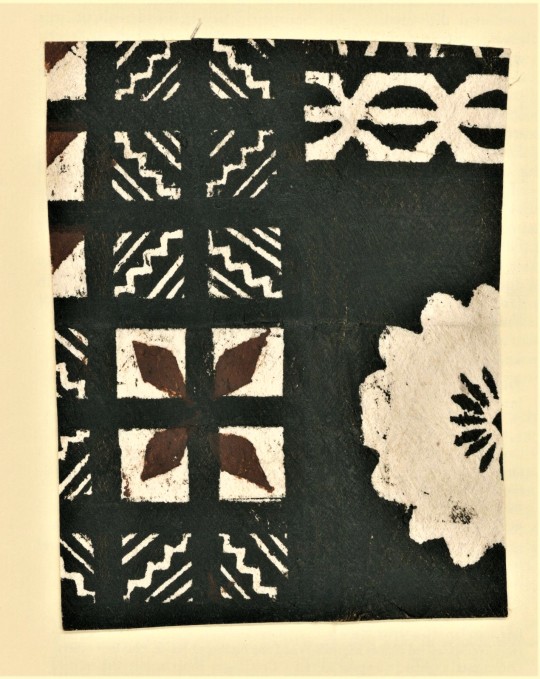

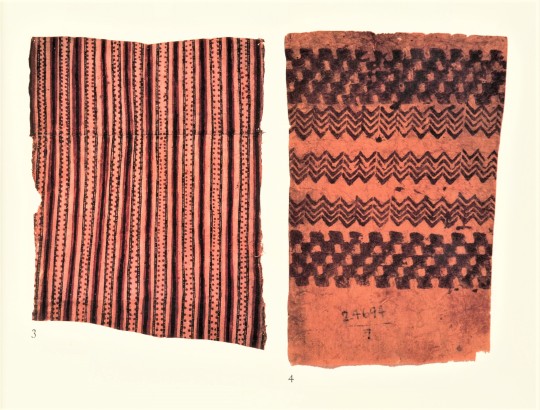
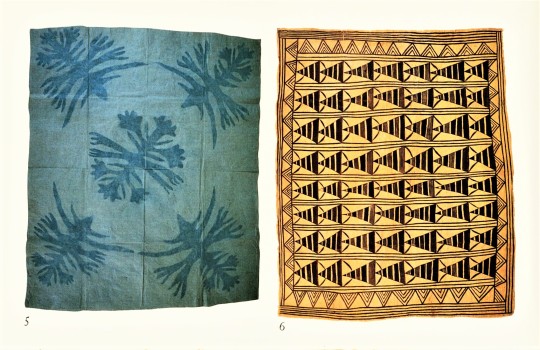
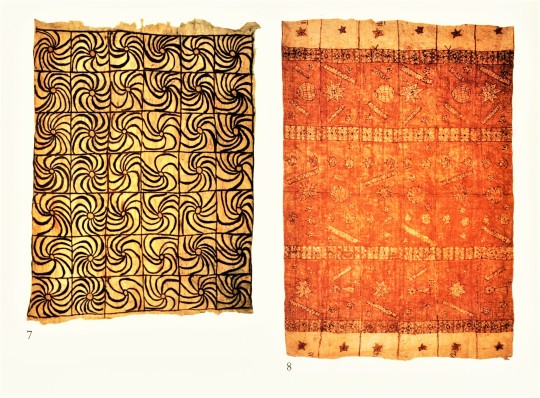

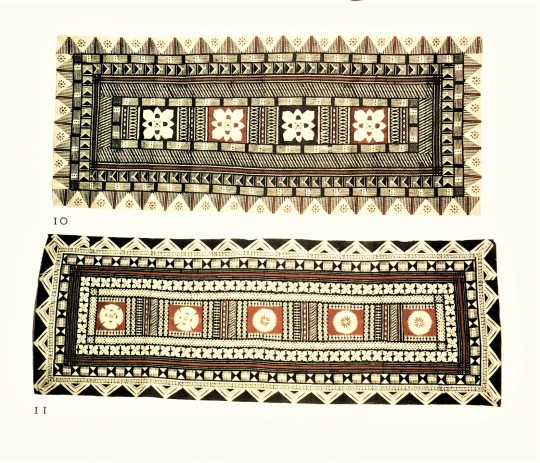

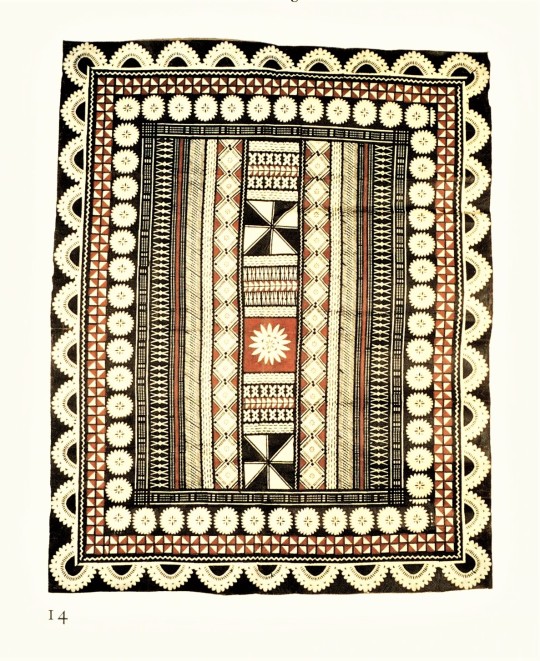
Decorative Sunday
POLYNESIAN BARKCLOTH
These images come from an article by noted New Zealand-based print historian Roderick Cave and New Zealand artist Jo Toor, “With Beam and Beetle: the Bark Cloth of the Pacific,” published in Matrix 11, Winter 1991, pp. 110-123. Bark cloth is a paper-like substrate called tapa. It is manufactured throughout the Pacific islands, but it is also known by other names such as kapa on the Hawaiian islands, siapo in Samoa, and masi in Fiji..
Tapa is made from the inner bark of the paper mulberry (Broussonetia papyrifera), the same plant that is used to make paper in China, Korea, and Japan. However, instead of beating the bark to separate the individual fibers to reform into paper, mulberry bark is simply pounded into a flat surface that is then smoothed over to make tapa. This substrate can then be decorated by painting, rubbing, stamping, stenciling, smoking, or dyeing.
Click on the images to see the captions.
Matrix 11 was printed in an edition of 955 copies by John and Rosalind Randle at the Whittington Press in England, and is a donation from our friend Jerry Buff.
View more posts from Matrix.
View other posts relating to the Whittington Press.
View more Decorative Sunday posts.
33 notes
·
View notes
Text
asal usul Permen Karet

Orang-orang telah menikmati permen karet sejak lama. Nenek moyang kita dari zaman neolitik pernah mengunyah permen karet yang terbuat dari kulit pohon Birch Bark atau nama aslinya adalah Betula papyrifera. Sedangkan budaya lain seperti Yunani kuno dan Indian Amerika juga mengunyah zat karet seperti yang terbuat dari resin dan residu dari pohon, rumput, dan juga tanaman lainnya.slottgacor
Parafin juga merupakan salah satu permen karet populer. Namun permen karet tersebut tidak dapat dikunyah sebelum dipanaskan terlebih dahulu dan dilembabkan di mulut. Pada tahun 1860, permen karet modern dengan zat yang disebut chicle mulai dikembangkan. Chicle awalnya diimpor dari Meksiko sebagai pengganti karet dan disadap dari pohon cemara tropis bernama Manilkara chicle dengan cara yang sama saat latex disadap dari pohon karet.polagacor
Permen karet chicle mulai terkenal dari permen karet biasa karena terbuat dari resin yang lebih halus, lembut, dan rasanya lebih tahan lama. Namun, sekarang ini permen karet dibuat dari bahan sintetis karena lebih murah dan juga lebih banyak tersedia di mana-mana.kartugg
0 notes
Text
Boswellia Market to See Huge Growth & Profitable Business 2024-2030

****Everything You Need to Know About Boswellia everything is Here....!
The Comprehensive study on Boswellia Market includes historical data as well as share, size, and projection information for the major players, geographies, applications, and product categories for the years 2024 to 2030. The Market study includes comprehensive insights on the competitive environment, description, broad product portfolio of key players, SWOT analysis, and significant business strategy implemented by rivals, revenue, Porters Five Forces Analysis, and sales projections. The report also features an impact analysis of the market dynamics, highlighting the factors currently driving and limiting market growth, and the impact they could have on the short, medium, and long-term outlook. The main goal of the paper is to further illustrate how the latest scenario, the economic slowdown, and war events affect the market for Boswellia.
Boswellia Market is growing at a +5% CAGR during the forecast period 2024-2030. The increasing interest of the individuals in this industry is that the major reason for the expansion of this market.
The Top Key Players profiled in the report:
Sabinsa Corporation, Arjuna Natural Extracts Pvt. Ltd., PLT health Solutions Inc., Alchem International Pvt. Ltd., Nutra Green Biotechnology Co. Ltd., Gurjar Pytochem Pvt. Ltd., S.A. Herbal Bioactives LLP, Alpspure Lifesciences Private Limited, Pharmanza Herbal Pvt. Ltd. and LAILA NUTRACEUTICALS.
Click the link to get a free sample copy of the report :
(*If you have any special requirements, please let us know and we will provide you with the report as you wish.)
Boswellia Market Segmentation:
Boswellia Market By Source 2019-2028, (IN USD Million)
Papyrifera
Sacra
Serrata
Cartetti
Boswellia Market By Application, 2019-2028, (IN USD Million)
Herbal Medicinal Products
Food Supplements
Personal Care Products
Aromatherapy
Others
Boswellia Market By Type, 2019-2028, (IN USD Million)
Resins
Essence Oils
Extracts
Based on geography, the global market for Boswellia and Disruptions has been segmented as follows:
North America (United States, Canada, Mexico)
South America (Brazil, Argentina, Ecuador, Chile)
Asia Pacific (China, Japan, India, Korea)
Europe (Germany, UK, France, Italy)
Middle East Africa (Egypt, Turkey, Saudi Arabia, Iran) and more.
Strategic Points Covered in Boswellia Market Directory:
To study and analyze the global market size (value & volume) by company, key regions/countries, products and application, history data, and forecast to 2030.
To understand the structure of market by identifying its various sub segments.
To share detailed information about the key factors influencing the growth of the market (growth potential, opportunities, drivers, industry-specific challenges and risks).
Focuses on the key global manufacturers, to define, describe and analyze the sales volume, value, market share, market competition landscape, SWOT analysis and development plans in next few years.
To analyze the growth trends, future prospects, and their contribution to the total market.
To project the value and volume of submarkets, with respect to key regions (along with their respective key countries).
To analyze competitive developments such as expansions, agreements, new product launches, and acquisitions in the market.
To strategically profile the key players and comprehensively analyze their growth strategies.
The report provides insights on the following pointers:
Market Penetration: Comprehensive information on the product portfolios of the top players in the Boswellia
Product Development/Innovation: Detailed insights on the upcoming technologies, R&D activities, and product launches in the market.
Competitive Assessment: In-depth assessment of the Boswellia market strategies, geographic and business segments of the leading players in the market.
Market Development: Comprehensive information about emerging markets. This report analyzes the market for various segments across geographies.
Market Diversification: Exhaustive information about new products, untapped geographies, recent developments, and investments in the Boswellia
Take a look at the full report with detailed TOC here:
Some of the key questions scrutinized in the study are:
Which companies are expanding litanies of products with the aim to diversify product portfolio?
Which companies have drifted away from their core competencies and how have those impacted the strategic landscape of the Boswellia market?
Which companies have expanded their horizons by engaging in long-term societal considerations?
Which firms have bucked the pandemic trend and what frameworks they adopted to stay resilient?
What are the marketing programs for some of the recent product launches?
We offer customization on the Boswellia market report based on specific client requirements:
20% free customization.
Five Countries can be added as per your choice.
Five Companies can add as per your choice.
Free customization for up to 40 hours.
After-sales support for 1 year from the date of delivery.
Get More: https://exactitudeconsultancy.com/primary-research/
Thank you for your interest in the Boswellia Market research publications; you can also get individual chapters or regional/country report versions such as Germany, France, China, Latin America, GCC, North America, Europe or Asia……
Other Reports:
Medical Composites market
Microcatheters market
Nuclear Imaging Equipment market
Optical Lens market
3D Print Photopolymer Parts market
About Us:
Exactitude Consultancy is a Market research & consulting services firm which helps its client to address their most pressing strategic and business challenges. Our professional team works hard to fetch the most authentic research reports backed with impeccable data figures which guarantee outstanding results every time for you. So, whether it is the latest report from the researchers or a custom requirement, our team is here to help you in the best possible way.
Contact: Exactitude Consultancy
PHONE NUMBER +1(704) 266-3234
EMAIL ADDRESS: [email protected]
#Boswellia Market#Boswellia Market growth#Boswellia Market size#Boswellia Market analysis 2024#Boswellia Market CAGR#Boswellia Growth#Boswellia Market 2024#Boswellia Market analysis by types#Boswellia Market data#Boswellia Market Outlook#Boswellia Market Size and Share#Boswellia Strategic Industry Latest News#Top Companies Analysis By Boswellia Market#Boswellia Market Trends#Boswellia Market Forecast#Boswellia Industry
0 notes
Text




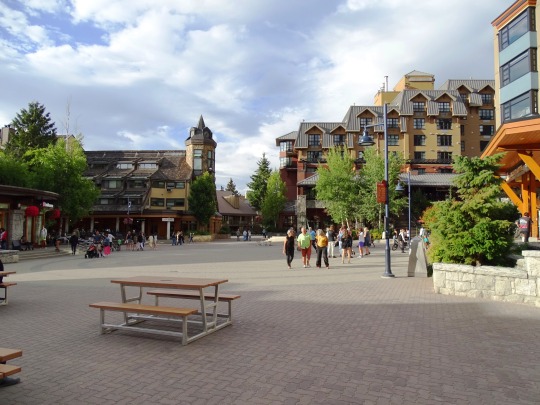





Whistler, BC (No. 7)
Both the valley floor and the mountain sides are characterized as mixed forest, predominantly conifers, but with a peppering of a few deciduous trees like the Pacific dogwood (Cornus nuttallii), locally extinct Pacific crabapple (Malus fusca) or Pryus fusca,[27] bitter cherry (Prunus emarginata), pin cherry (Prunus pensylvanica), choke cherry (Prunus virginiana),[28] Red Alder (Alnus rubra), Sitka Alder (Alnus sinuata), Paper Birch (Betula papyrifera), big leaf maple (Acer macrophyllum), Douglas maple (Acer glabrum)
Whistler was clear cut twice. The Oregon Grape Mahonia aquifolium (AKA hollyleaved barberry) USDA Plants Database and Highbush Cranberry Viburnum opulus were accidentally re-introduced as escaped landscaping plants, and may all be Oregonian subspecies. All the wild Pacific crabapples were dug up by Pemberton Pioneers for grafting Rootstock. It is unclear whether the Chickasaw Plum, Prunus americana was indigenous, or introduced by Indigenous Transcontinental Trade Networks or later Western Contact. All the wild Plums were dug up too by Pemberton Pioneers for fruit trees to transplant and as rootstock. Once abundant on the forest floor, Lingonberry Vaccinium vitis-idaea is no longer found because of the loss of habitat through the clear-cutting.
Source: Wikipedia
#travel#original photography#vacation#tourist attraction#landmark#landscape#clouds#nature#cityscape#flora#Canada#summer 2023#British Columbia#blue sky#countryside#snow#forest#tree#Whistler#woods#fir#pine#Coast Mountains#Pacific Ranges#small town#architecture#flower#Fitzsimmons Creek#Totem by Ken Mowatt#river bank
1 note
·
View note
Text
Papiermaulbeerbaum - Broussonetia papyrifera
Moraceae / Maulbeergewächs aus Myanmar und China
Weibliche Form; wächst am Hauptweg zu den Gewächshäusern

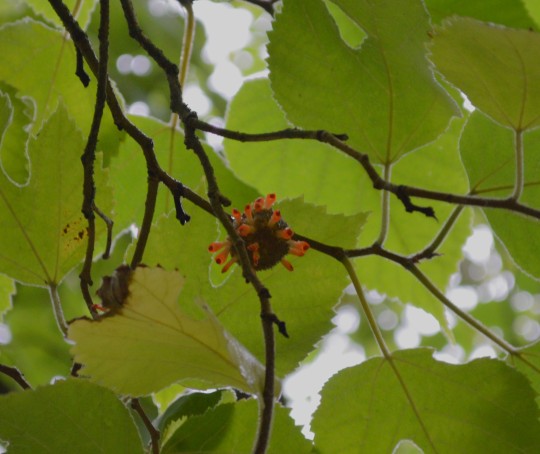
#botanical garden#botanischer garten#kiel#flowers of tumblr#plants#plants of tumblr#pflanzen#maulbeere
0 notes
Text
0 notes
Text
Choosing a 7B Landscape Tree for Your Marietta Yard

Need help selecting the best tree for your Hardiness zone 7b yard? Understanding different tree species’ characteristics and growing habits will help you plant a tree that fits perfectly in your yard.
toddsmariettatreeservices.com gathered the following tree species and growing information for zone 7b landscape trees.
What is a Landscaping Tree?
Landscaping trees are planted to create diversity and serve one of many purposes on your property. These trees come in all shapes and sizes and can be among the most significant assets to your yard by providing shade, privacy screens, wind protection, wildlife refuge, visual interest (curb appeal), and other uses.
What are the Benefits of Landscape Trees?
Landscape trees reduce air pollution and noise pollution. They also filter water and absorb rainfall, lessening the impact of flood and stormwater and preventing soil erosion. Trees also attract a variety of birds and natural wildlife, providing food and shelter.
Note: A large, healthy tree can absorb approximately 40,000 gallons of groundwater annually, returning it to the atmosphere through evapotranspiration.
What are the Best Trees for Your Front Yard?
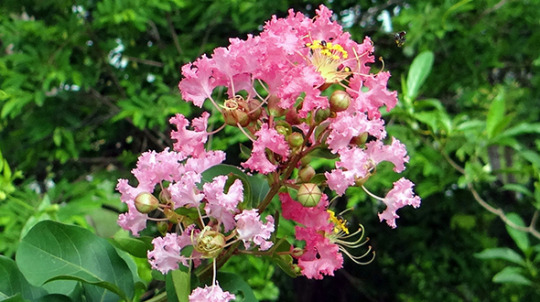
Flowers add pops of color, and mulch creates a clean, well-manicured look. With trees, you can balance height and width in your landscape. Trees are among the best ways to draw the eye, add height, and create a relaxing balance. Curb appeal helps sell a home (trees significantly contribute to curb appeal), and here are a few of the best front yard trees:
Crepe Myrtle (Lagerstroemia) reaches 15 feet
Blue Spruce (Picea pungens) reaches 75 feet
Cherry (Prunus avium) reaches 25 to 30 feet
River Birch (Betula nigra) reaches 60 to 70 feet
Magnolia (Magnolia) reaches 70 to 80 feet
Tip: Avoid catastrophic structural damages by planting your trees at a safe distance from structures on your landscape.
What are the Most Low-Maintenance Landscape Trees?

Once you have determined your tree’s purpose in your landscape (flowers, evergreen shade, privacy, etc.), you should consider the tree’s maintenance. Some landscape plants drop fruit and nuts, while others grow with invasive or surface roots, disturbing your yard, driveway, and foundation. Consider the following low-maintenance landscape trees:
Japanese Maple (Acer palmatum) reaches 25 to 35 feet with delicate branches and vibrant foliage
Jacaranda (Jacaranda) reaches 25 to 40 feet with striking blue and lavender flowers
Redbud (Cercis) reaches 10 to 20 feet with deep red, bright yellow, or two-colored foliage
Frangipani (Plumeria) reaches 20 to 25 feet with non-invasive roots and an abundance of beautiful flowers
Cherry Plum (Prunus cerasifera) reaches 25 feet with deep purple foliage and pink/white flowers
Tip: All tree species require seasonal pruning and thorough inspection after severe weather.
What are the Best Trees to Plant Near a House?

Smaller trees with shallow or non-invasive roots pose little or no risk to your home. Consider the following low-risk tree species:
Weeping Willow (Salix babylonica) reaches 30 to 40 feet
Paper Birch (Betula papyrifera) reaches 50 to 70 feet
Silver Maple (Acer saccharinum) reaches 50 to 80 feet
Sweetgum (Liquidambar) reaches 60 to 75 feet
Crabapple (Malus) reaches 15 to 20 feet
Tip: Towering tree species like southern pines and eucalyptus should be given extra space and not planted within 40 to 50 feet of landscape structures.
Why do Landscape Designers Prefer Male Trees?
Trees with male reproductive organs are preferred in landscapes because they don’t drop messy seed pods or fruit. However, they do produce and release pollen.
Note: When female trees, which capture pollen, are absent from significant landscape areas, the entire area can be blanketed by mass amounts of pollen.
What is the Best Pine Tree to Plant in Zone 7b?
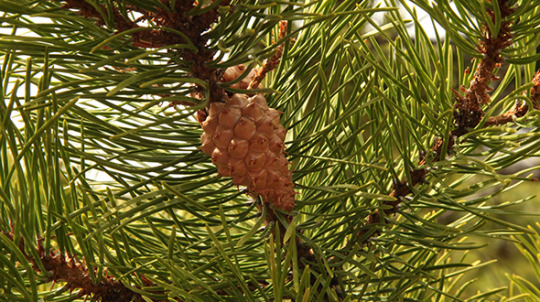
Pine trees are often used in landscapes as privacy screens and specimen trees because they are fast-growing, shapely, and evergreen. Consider the following pine tree species for your landscape needs:
Loblolly Pine (Pinus taeda) reaches 60 to 90 feet
Austrian or Black Pine (Pinus nigra) reaches 50 to 60 feet and requires ample space to flourish
Lodgepole Pine (Pinus contorta) reaches 70 to 80 feet
Red Pine (Pinus resinosa) reaches 50 to 80 feet
Eastern White Pine (Pinus strobus) reaches 50 to 80 feet
Tip: Avoid planting pines near driveways and carports (overhanging branches can leave your vehicle or structure riddled with sap droppings). Pine trees produce and drip sap. The sap flow is heaviest in spring and early summer. During winter, sap slows down and picks up again as spring approaches.
Marietta Georgia Zone 7b Landscape Trees
In this article, you discovered species information and growing characteristics for several popular zone 7b landscape trees.
Knowing which trees to plant around your home and landscape will help you create a beautiful yard with purpose and elevated curb appeal.
Planting the wrong tree species in the wrong location can result in catastrophic root damage to your landscape, driveway, pathway, foundation, and home if it falls on your roof.
Sources:
usgs.gov/special-topics/water-science-school/science/evapotranspiration-and-water-cycle#overview
extension.tennessee.edu/publications/Documents/SP517.pdf
extension.uga.edu/publications/detail.html?number=b625#title11
uaex.uada.edu/publications/pdf/FSA-6126.pdf
Todd’s Marietta Tree Services
Marietta, GA
(678) 505-0266
For the original version of this article visit: https://www.toddsmariettatreeservices.com/choosing-a-7b-landscape-tree-for-your-marietta-yard/
#Landscape Tree#USDA Hardiness Zone 7B#Zone 7B#Marietta Landscape#Tree Service Marietta Ga#Emergency Tree Removal Marietta Ga
1 note
·
View note
Photo
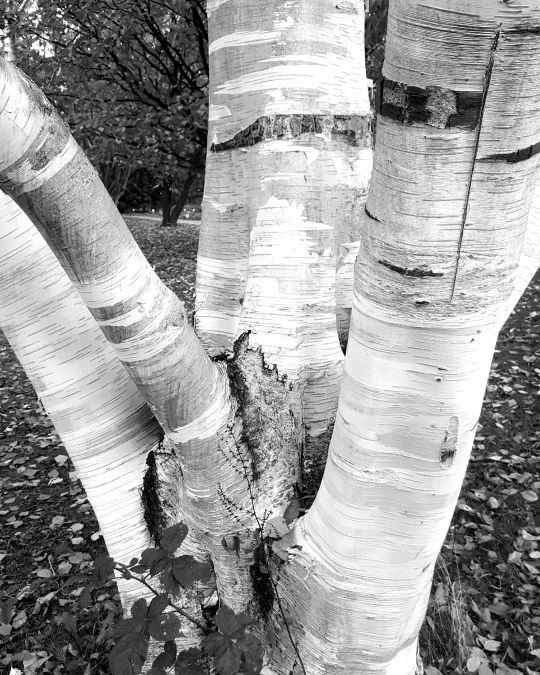
Papierbirke Betula papyrifera @butterbaum_kiel #birke #blackandwhite #swfotografie (hier: Botanischer Garten Kiel)
0 notes
Text


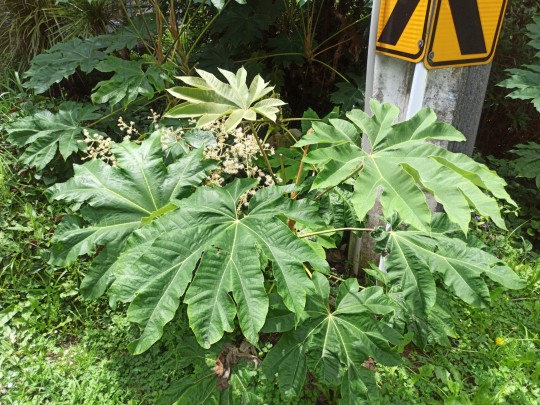
Tetrapanax papyrifer (rice-paper plant, or 通草—tong cao) is an evergreen shrub in the family Araliaceae, the sole species in the genus Tetrapanax. The specific epithet is frequently misspelled as "papyriferum", "papyriferus", or "papyrifera". It is endemic to Taiwan, but widely cultivated in East Asia and sometimes in other tropical regions as well. The species was once included in the genus Fatsia as Fatsia papyrifera.
328-366 Huia Road, Titirangi, Auckland 0604
3J2G+2PQ Auckland
-36.9499110, 174.6268500
0 notes
Text

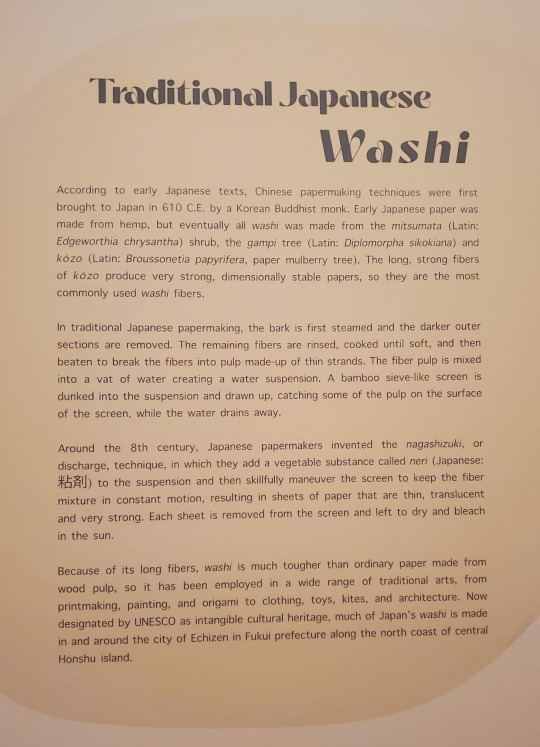
Welcome to the inaugural series of this blog! On 11/23I went to the Morikami Museum & Gardens in Delray Beach, FL., where there was an exhibit on art created with traditional Japanese paper and papermaking techniques. The nine modern artists featured are Aoyama Hina, Horiki Eriko, Ibe Kyoko, Ikezaki Yoshio, Ishii Kakuko, Kimura Yuko, Nishimura Yuko, Tanaka Takaaki, and Yoshida Ayomi. The exhibition runs from November 5, 2022 to April 2, 2023.
Washi Transformed: New Expressions in Japanese Paper
"For over 1000 years, Japan has produced some of the world's finest paper, using strong natural fibers and exceptional production techniques passed down through the generations. Japanese handmade paper, known as washi (Japanese: 和紙) is still made in some areas of Japan and used in painting, calligraphy, origami and other traditional art forms.
Recently, contemporary Japanese artists have been turning to this supple yet sturdy material, using it as a medium for creating highly textured two-dimensional works, complex sculptures, and dramatic installations. Employing techniques ranging from layering, weaving and dying, to twisting, folding, and cutting these artists demonstrate the endless contemporary applications of this ancient material.
Washi Transformed focuses on washi as a medium for contemporary art in Japan and spotlights the works of nine very different contemporary Japanese artists who are exploring the artistic potential of this traditional material. The artists: Aoyama Hina, Horiki Eriko, Ibe Kyoto, Ikezaki Yoshio, Ishii Kakuko, Kimura Yuko, Nishimura Yuko, Tanaka Takaaki, Yoshida Ayomi - all push the boundaries of Japanese washi art in terms of texture, dimension and scale, creating works that challence our assumptions about the nature of the material. Their abstract paper sculptures, lyrical folding screens, dramatic installations and highly textured wall pieces all demonstrate the resilience and versatility of washi as a medium in the realm of international contemporary art."
Traditional Japanese Washi
"According to early Japanese texts, Chinese papermaking techniques were first brought to Japan in 610 C.E. by a Korean Buddhist monk. Early Japanese paper was made from hemp, but eventually all washi was made from the mitsumata (Latin: Edgeworthia chrysantha) shrub, the gampi tree (Latin: Diplomorpha sikokiana) and kōzo (Latin: Broussonetia papyrifera, paper mulberry tree). The long, strong fibers of kōzo produce very strong, dimensionally stable papers, so they are the most commonly used washi fibers.
In traditional Japanese papermaking, the bark is first steamed and the darker outer sections are removed. The remaining fibers are rinsed, cooked until soft, and then beaten to break the fibers into pulp made-up of thin strands. The fiber pulp is mixed into a vat of water creating a water suspension. A bamboo sieve-like screen is dunked into the suspension and drawn up, catching some of the pulp on the surface of the screen, while the water drains away.
Around the 8th century, Japanese papermakers invented the nagashizuki, or discharge, technique, in which they add a vegetable substance called neri (Japanese: 粘剤) to the suspension and then skillfully maneuver the screen to keep the fiber mixture in constant motion, resulting in sheets of paper that are thin, translucent and very strong. Each sheet is removed from the screen and left to dry and bleach in the sun.
Because of its long fibers, washi is much tougher than ordinary paper made from wood pulp, so it has been employed in a wide range of traditional arts, from printmaking, painting, and origami to clothing, toys, kites, and architecture. Now designated by UNESCO as intangible cultural heritage, much of Japan's washi is made in and around the city of Echizen in Fukui prefecture along the north coast of central Honshu island."
(Source: Morikami Museum & Gardens Exhibit)
1 note
·
View note